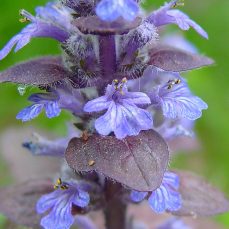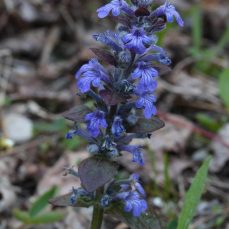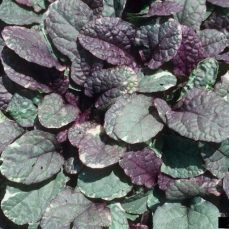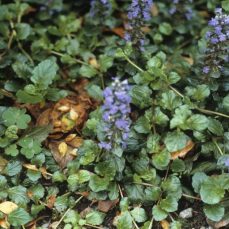
Photo Credit: Gardeners World
Synonyms
Bugleweed, common bugle, carpet bugle, ajuga
ID Characteristics
General: Bugle weed is a low-growing, evergreen, perennial plant in the mint family (Lamiaceae), commonly used as a low-maintenance ground cover.
Flowers: Groups of 5 – 7 flowers arranged wrapping around a single stem with a leafy, terminal end, on spikes rising above the foliage. The blue-violet flowers have a small upper lip and larger, 3-lobed, bell-shaped, 5 – 6 mm long lower lip.
Stem: Are square, erect, and slightly hairy. Bugle weed can reach 10 – 30 cm tall.
Leaves: Are oval-shaped, shiny and dark green with burgundy highlights, 7.5 – 10 cm long. Bugle weed leaves grow in rosettes. Leaves on the stem are noticeably smaller than the ground-covering rosette leaves. The uppermost leaves are smaller than the flowers and often blue-tinted.
Fruit: Clusters of 4 nutlets that are egg-shaped and pitted across the surface.
Roots: Bugle weed has fibrous, shallow roots and rooting runners. Ground runners can be up to 50 cm long.
Similar Species
Native
Blue verbena (Verbena hastata) grows much taller than bugle weed.

Photo credit: Ryan Batten
Invasive
Purple deadnettle (Lamium purpureum) has red-purple flowers, while bugle weed has blue-violet flowers.

Photo credit: Ansel Oommen
Habitat and Origin
Bugle weed is native to Europe, Northern Africa, Southwest Asia, and Southern Russia. It was introduced to Canada in 1884 and has since spread throughout North America.
Bugle weed prefers moist, well-drained soils in partial shade but will tolerate all light levels and moderately dry soil. It is commonly found in rich forests, yards, meadows, roadsides, and ballast soil.
How it Spreads
Bugle weed reproduces vegetatively through stolons or ‘runners’ that spread from the parent plant, take root in the soil, and produce a new rosette ‘daughter’ plant. This quickly forms a dense monoculture. Bugle weed is monoecious (male and female flowers are found on the same plant) and self-seeding.
Bugle weed is spread by the horticulture trade, as it is unfortunately still planted as a ground cover. Once planted in a garden, it quickly escapes its confines. Bugle weed can also be spread in contaminated soil or by machinery.
Impacts
Ecological:
- Reduces biodiversity by forming a dense mat of ground cover that outcompetes and chokes out native species.
Economic:
- Reduces crop value and harvesting efficiency.
- All parts of the plant are toxic if ingested, therefore reducing grazing area for livestock.
Prevent the Spread
Bugle weed is widespread in the Sea to Sky region, and site-scale control options are either ineffective or futile. While bugle weed is not included in SSISC’s control programs, we recommend that its cultivation be avoided.
Learn to identify bugle weed: use the images presented in this profile page to learn how to identify bugle weed
What to do if you spot it: You can report any bugle weed sighting by clicking here.
DO:
- Regularly monitor properties for weed infestations.
- Ensure soil and gravel are uncontaminated before transport.
- Ensure plants are disposed of in a garbage bag if found in floral arrangements to prevent seeds from spreading.
DO NOT:
- Unload, park or store equipment or vehicles in infested areas; remove plant material from any equipment, vehicles or clothing used in such areas and wash equipment and vehicles at designated cleaning sites before leaving infested areas.
- Plant Bugle Weed in a garden, no matter how well-contained its enclosure may seem.
- Move soil that has been contaminated with Bugle Weed.
- Compost Bugle Weed!
Control
Mechanical
- Bugle Weed is easily controlled by hand pulling.
- Watering the infested patch the day before pulling will loosen up the roots and make them easier to remove.
- Try to remove as much of the roots as you can, as small fragments in the soil can cause the plant to re-sprout.
- Mowing or deadheading can help prevent Bugle Weed from self-seeding but will not eradicate an infestation.
- Large patches can be smothered with black plastic and left to ‘bake’ in the sun for at least two weeks.
Chemical
- Bugle Weed can be controlled using a homemade herbicide of equal parts hot water and vinegar with a pinch of salt and few drops of dish soap. This can be applied using a spray bottle. Limit your coverage to affected areas only.
- If that does not work, a broadleaf herbicide can be used.
We recommend that any herbicide application is carried out by a person holding a valid BC Pesticide Applicator Certificate. Before selecting and applying herbicides, you must review and follow herbicide labels and application rates; municipal, regional, provincial and federal laws and regulations; species-specific treatment recommendations, and site-specific goals and objectives.
Biological
There is no biocontrol available for this plant.
B.C. Distribution
Bugle Weed Factsheet
Having trouble viewing the factsheet? Don’t worry, all the information is included on this page. You can also contact us with any questions.
References
- Dave’s Garden, Ajuga Species, Blue Bugle, Carpet Bugle, Common Bugleweed
- Electronic Atlas of the Flora of BC, Ajuga reptans
- Gardenia, Ajuga reptans (Carpet bugle)
- Gardening Know How, Treating Bugleweeds: Learn How To Control Ajuga Plants
- Invasive Plants Atlas of the United States, Carpet bugle
- Invasive Species Compendium, Ajuga reptans (carpet bugle)
- Missouri Botanical Garden, Ajuga reptans
- Natureserve Explorer, Ajuga reptans
- NatureGate, Blue Bugle
- North Carolina State Extension, Ajuga reptans
- Ohio State University Horticulture in Virtual Perspective, Ajuga reptans
- Ontario Invasive Plant Council, Grow Me Instead: A Guide for Southern Ontario
- Weeds of Australia, Ajuga reptans
- Wikipedia, Ajuga reptans










